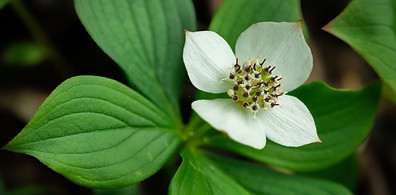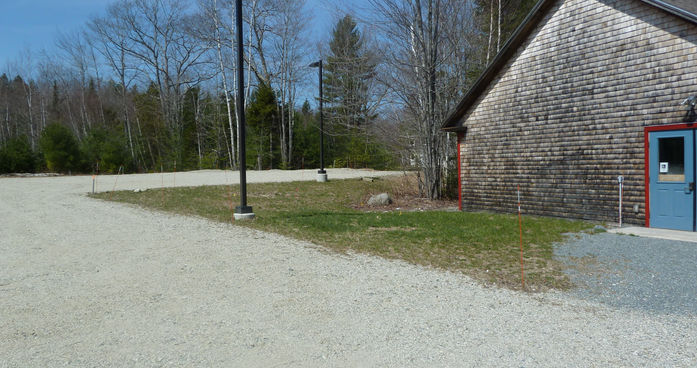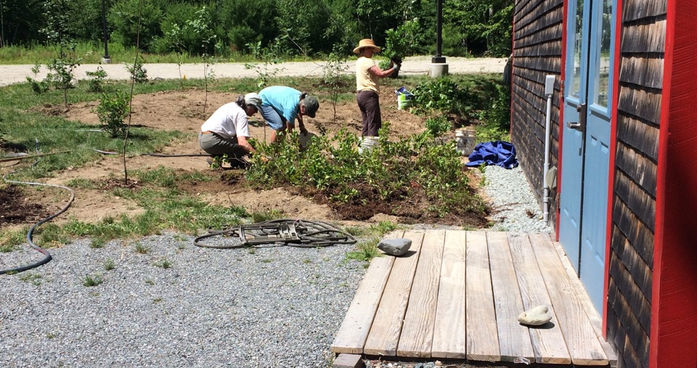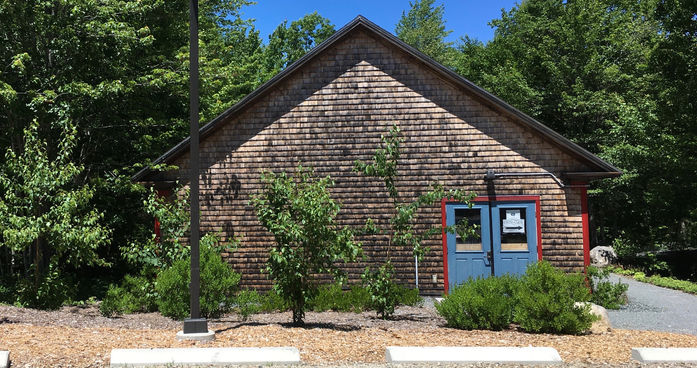
Performance Hall Garden
Established 2016
SITE CONDITIONS
Light: Part shade to full shade in the woodland basin; full sun in the birch planting.
Soil type: Loamy in the woodland basin; sandy loam in the birch planting.
Soil moisture: Medium to medium-dry, seasonally moist in the basin.
Topography: The woodland planting is located within a natural basin. The birch planting is flat and gradually slopes towards the building.
Key plants in birch planting: Bayberry (Morella pensylvanica), Huckleberry (Gaylussacia baccata), Paper birch (Betula papyifera), and Common juniper (Juniperus communis).
Key plants in woodland planting: Bunchberry (Chaemypericlimenum canadense), Eastern red columbine (Aquilegia canadensis), Lowbush blueberry (Vaccinium angustifolium), Mapleleaf Viburnum (Viburnum acerifolium), Northern Maidenhair Fern (Adiantum pedatum), Red maple (Acer rubrum), Wild sarsaparilla (Aralia nudicaulis), White baneberry (Actaea pachypoda), Yellow birch (Betula alleghaniensis).


OVERVIEW
In 2016, we transformed a lawn area by planting sapling paper birches, which have since formed a canopy that provides shade to the front of the building. Bayberry occupies the midstory, while huckleberry and common juniper form the understory of this simple and seasonally appealing planting. Early successional plants like these are easy to establish by smothering lawn with cardboard and wood chips, then planting into the undisturbed soil that once supported turf grass.
Another lawn area was transformed into a woodland garden along the side of the building. The existing canopy of yellow birch and red maple provided a natural backdrop, which we enhanced by adding shrubs and herbaceous plants to the dry, shaded areas along the path.
Woodland plants are less adapted to disturbed soil compared to many popular native species suited for sunnier spots. They often have complex germination needs, which can take over a year to initiate and up to seven years to flower. These plants require leaf litter for optimal germination, but earthworms accelerate leaf decomposition, which can disrupt germination and growth.
Due to the specific needs of woodland plants, they are less available in nurseries. Species like lady's slipper and trillium are often best appreciated in their natural habitats. In a garden setting, adding leaf mulch is a way to restore conditions that favor soil microbes which help woodland plants obtain nutrients. By introducing responsibly grown woodland plants into our gardens, we are providing a seed source that may help restore diversity in forested areas affected by deer, earthworms, and historical land use.
Exciting Ecology
Bunchberry flowers, encased in a ring of four white bracts - often mistaken for petals - can open in under half a millisecond and propel their pollen grains more than three feet away. Plants with exploding flowers such as these depend not only on insects for pollination but have evolved ingenious mechanisms to disperse their pollen effectively.
The spring azure butterfly lays its eggs on Viburnums like the maple-leaved viburnum in the woodland area of this garden. Once the eggs hatch, the larvae feed on flower buds instead of the typical diet of foliage. Neighboring ants play a crucial role in protecting and feeding the larvae, which, in turn, provide the ants with honeydew. The ants even transport the larvae to their nests, caring for them until they pupate. Keep your eye out for spring azure larvae and their ant friends. The female adult spring azures can be found on milkweed, dogbane or blackberries and the males can be seen dabbling in mud puddles lapping up mineral-rich water.

Bunchberry, Chamaepericlymenum canadense, can propel its pollen more than three feet away.
Photo credit: Martha B. Moss





























